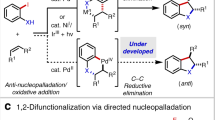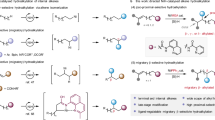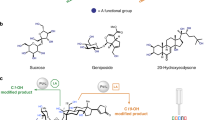Abstract
Current methods for functional group interconversion have, for the most part, relied on relatively strong driving forces which often require highly reactive reagents to generate irreversibly a desired product in high yield and selectivity. These approaches generally prevent the use of the same catalytic strategy to perform the reverse reaction. Here we describe a catalytic functional group metathesis approach to interconvert, under CO-free conditions, two synthetically important classes of electrophiles that are often employed in the preparation of pharmaceuticals and agrochemicals—aroyl chlorides (ArCOCl) and aryl iodides (ArI). Our reaction design relies on the implementation of a key reversible ligand C–P bond cleavage event, which enables a non-innocent, metathesis-active phosphine ligand to mediate a rapid aryl group transfer between the two different electrophiles. Beyond enabling a practical and safer approach to the interconversion of ArCOCl and ArI, this type of ligand non-innocence provides a blueprint for the development of a broad range of functional group metathesis reactions employing synthetically relevant aryl electrophiles.
This is a preview of subscription content, access via your institution
Access options
Access Nature and 54 other Nature Portfolio journals
Get Nature+, our best-value online-access subscription
$29.99 / 30 days
cancel any time
Subscribe to this journal
Receive 12 print issues and online access
$259.00 per year
only $21.58 per issue
Buy this article
- Purchase on Springer Link
- Instant access to full article PDF
Prices may be subject to local taxes which are calculated during checkout



Similar content being viewed by others
References
Smith, M. B.March’s Advanced Organic Chemistry: Reactions, Mechanisms, and Structure. (Wiley, Hoboken, 2013).
Terrier, F. Modern Nucleophilic Aromatic Substitution (Wiley, Hoboken, 2013).
Ackermann, L. Modern Arylation Methods (Wiley: Hoboken, 2009).
Friis, S. D., Lindhardt, A. T. & Skrydstrup, T. The development and application of two-chamber reactors and carbon monoxide precursors for safe carbonylation reactions. Acc. Chem. Res. 49, 594–605 (2016).
Wu, L., Liu, Q., Jackstell, R. & Beller, M. Carbonylations of alkenes with CO surrogates. Angew. Chem. Int. Ed. 53, 6310–6320 (2014).
Zollinger, H. Diazo Chemistry I: Aromatic and Heteroaromatic Compounds 11–37 (VCH, Weinheim, 1994).
Quesnel, J. S. & Arndtsen, B. A. A palladium-catalyzed carbonylation approach to acid chloride synthesis. J. Am. Chem. Soc. 135, 16841–16844 (2013).
Quesnel, J. S. et al. Computational study of the palladium-catalyzed carbonylative synthesis of aromatic acid chlorides: the synergistic effect of PtBu3 and CO on reductive elimination. Chem. Eur. J. 22, 15107–15118 (2016).
Ohno, K. & Tsuji, J. Organic synthesis by means of noble metal compounds. XXXV. Novel decarbonylation reactions of aldehydes and acyl halides using rhodium complexes. J. Am. Chem. Soc. 90, 99–107 (1968).
Malapit, C. A., Ichiishi, N. & Sanford, M. S. Pd-catalyzed decarbonylative cross-couplings of aroyl chlorides. Org. Lett. 19, 4142–4145 (2017).
Petrone, D. A., Ye, J. & Lautens, M. Modern transition-metal-catalyzed carbon−halogen bond formation. Chem. Rev. 116, 8003–8104 (2016).
Ochiai, H., Uetake, Y., Niwa, T. & Hosoya, T. Rhodium-catalyzed decarbonylative borylation of aromatic thioesters for facile diversification of aromatic carboxylic acids. Angew. Chem. Int. Ed. 56, 2482–2486 (2017).
Perry, G. J. P., Quibell, J. M., Panigrahi, A. & Larrosa, I. Transition-metal-free decarboxylative iodination: new routes for decarboxylative oxidative cross-couplings. J. Am. Chem. Soc. 139, 11527–11536 (2017).
Roy, A. H. & Hartwig, J. F. Directly observed reductive elimination of aryl halides from monomeric arylpalladium(ii) halide complexes. J. Am. Chem. Soc. 125, 13944–13945 (2003).
Roy, A. H. & Hartwig, J. F. Reductive elimination of aryl halides from palladium(ii). J. Am. Chem. Soc. 123, 1232–1233 (2001).
Shen, X., Hyde, A. M. & Buchwald, S. L. Palladium-catalyzed conversion of aryl and vinyl triflates to bromides and chlorides. J. Am. Chem. Soc. 132, 14076–14078 (2010).
Grubbs, R. H. Handbook of Metathesis (Wiley, Weinheim, 2003).
Fürstner, A. Alkyne metathesis on the rise. Angew. Chem. Int. Ed. 52, 2794–2819 (2013).
Geyer, A. M., Gdula, R. L., Wiedner, E. S. & Johnson, M. J. A. Catalytic nitrile–alkyne cross-metathesis. J. Am. Chem. Soc. 129, 3800–3801 (2007).
Ludwig, J. R., Zimmerman, P. M., Gianino, J. B. & Schindler, C. S. Iron(iii)-catalysed carbonyl–olefin metathesis. Nature 533, 374–379 (2016).
Ma, L. et al. FeCl3-catalyzed ring-closing carbonyl–olefin metathesis. Angew. Chem. Int. Ed. 55, 10410–10413 (2016).
Chung, R., Vo, A. & Hein, J. E. Copper-catalyzed hydrogen/iodine exchange in terminal and 1-iodoalkynes. ACS Catal. 7, 2505–2510 (2017).
Lyons, J. E. Group VIII metal complexes as catalysts for halogen exchange between alkyl halides. J. Chem. Soc. Chem. Commun. 418–419 (1975).
Ackerman, L. K. G., Lovell, M. M. & Weix, D. J. Multimetallic catalysed cross-coupling of aryl bromides with aryl triflates. Nature 524, 454–457 (2015).
van der Vlugt, J. I. & Reek, J. N. H. Neutral tridentate PNP ligands and their hybrid analogues: versatile non-innocent scaffolds for homogeneous catalysis. Angew. Chem. Int. Ed. 48, 8832–8846 (2009).
Lyaskovskyy, V. & de Bruin, B. Redox non-innocent ligands: versatile new tools to control catalytic reactions. ACS Catal. 2, 270–279 (2012).
Abatjoglou, A. G. & Bryant, D. R. Aryl group interchange between triarylphosphines catalyzed by Group VIII transition metals. Organometallics 3, 932–934 (1984).
Grushin, V. V. Thermal stability, decomposition paths, and Ph/Ph exchange reactions of [(Ph3P)2Pd(Ph)X] (X = I, Br, Cl, F, and HF2). Organometallics 19, 1888–1900 (2000).
Lian, Z., Bhawal, B. N., Yu, P. & Morandi, B. Palladium-catalyzed carbon–sulfur or carbon–phosphorus bond metathesis by reversible arylation. Science 356, 1059–1063 (2017).
Baba, K., Masuya, Y., Chatani, N. & Tobisu, M. Palladium-catalyzed cyclization of bisphosphines to phosphacycles via the cleavage of two carbon–phosphorus bonds. Chem. Lett. 46, 1296–1299 (2017).
Kong, K.-C. & Cheng, C.-H. Facile aryl−aryl exchange between the palladium center and phosphine ligands in palladium(ii) complexes. J. Am. Chem. Soc. 113, 6313–6315 (1991).
Goodson, F. E., Wallow, T. I. & Novak, B. M. Mechanistic studies on the aryl−aryl interchange reaction of ArPdL2I (L = triarylphosphine) complexes. J. Am. Chem. Soc. 119, 12441–12453 (1997).
Fiebig, L., Schlörer, N., Schmalz, H.-G. & Schäfer, M. Aryl−phenyl scrambling in intermediate organopalladium complexes: a gas-phase study of the Mizoroki–Heck reaction. Chem. Eur. J. 20, 4906–4910 (2014).
Marcoux, D. & Charette, A. B. Palladium-catalyzed synthesis of functionalized tetraarylphosphonium salts. J. Org. Chem. 73, 590–593 (2008).
Sakamoto, M., Shimizu, I. & Yamamoto, A. Palladium-catalyzed cleavage of P–C bonds in quaternary phosphonium salts and its applications to organic synthesis. Chem. Lett. 24, 1101–1102 (1995).
Hwang, L. K., Na, Y., Lee, J., Do, Y. & Chang, S. Tetraarylphosphonium halides as arylating reagents in Pd-catalyzed heck and cross-coupling reactions. Angew. Chem. Int. Ed. 44, 6166–6169 (2005).
Miloserdov, F. M. et al. The challenge of palladium-catalyzed aromatic azidocarbonylation: from mechanistic and catalyst deactivation studies to a highly efficient process. Organometallics 33, 736–752 (2014).
Acknowledgements
We thank Z. K. Wickens (Harvard University) for a critical proofreading of this manuscript. Generous funding from the Max-Planck-Society, the Max-Planck-Institut für Kohlenforschung and LG Chem (fellowship to Y.H.L.) is acknowledged. We thank B. List for sharing analytical equipment, and our NMR spectroscopy, mass spectrometry and X-ray departments for technical assistance.
Author information
Authors and Affiliations
Contributions
Y.H.L. and B.M. conceived the project and prepared the manuscript. B.M. directed the work. Y.H.L. developed and studied the reaction experimentally. Both the authors analysed the data.
Corresponding author
Ethics declarations
Competing interests
The authors declare no competing interests.
Additional information
Publisher’s note: Springer Nature remains neutral with regard to jurisdictional claims in published maps and institutional affiliations.
Supplementary information
Supplementary information
Supplementary experimental details and compound characterization data
Crystallographic data
CIF for compound 70; CCDC reference: 1829364
Rights and permissions
About this article
Cite this article
Lee, Y.H., Morandi, B. Metathesis-active ligands enable a catalytic functional group metathesis between aroyl chlorides and aryl iodides. Nature Chem 10, 1016–1022 (2018). https://doi.org/10.1038/s41557-018-0078-8
Received:
Accepted:
Published:
Issue Date:
DOI: https://doi.org/10.1038/s41557-018-0078-8
This article is cited by
-
A metal-catalysed functional group metathesis approach to the carbon isotope labelling of carboxylic acids
Nature Chemistry (2024)
-
Carbon isotope exchange for pharmaceutical radiolabelling through metal-catalysed functional group metathesis
Nature Chemistry (2024)
-
Palladium-catalyzed regiodivergent hydrochlorocarbonylation of alkenes for formation of acid chlorides
Nature Communications (2023)
-
Fragmentation and reassembly
Nature Chemistry (2021)
-
Palladium-catalysed carboformylation of alkynes using acid chlorides as a dual carbon monoxide and carbon source
Nature Chemistry (2021)



